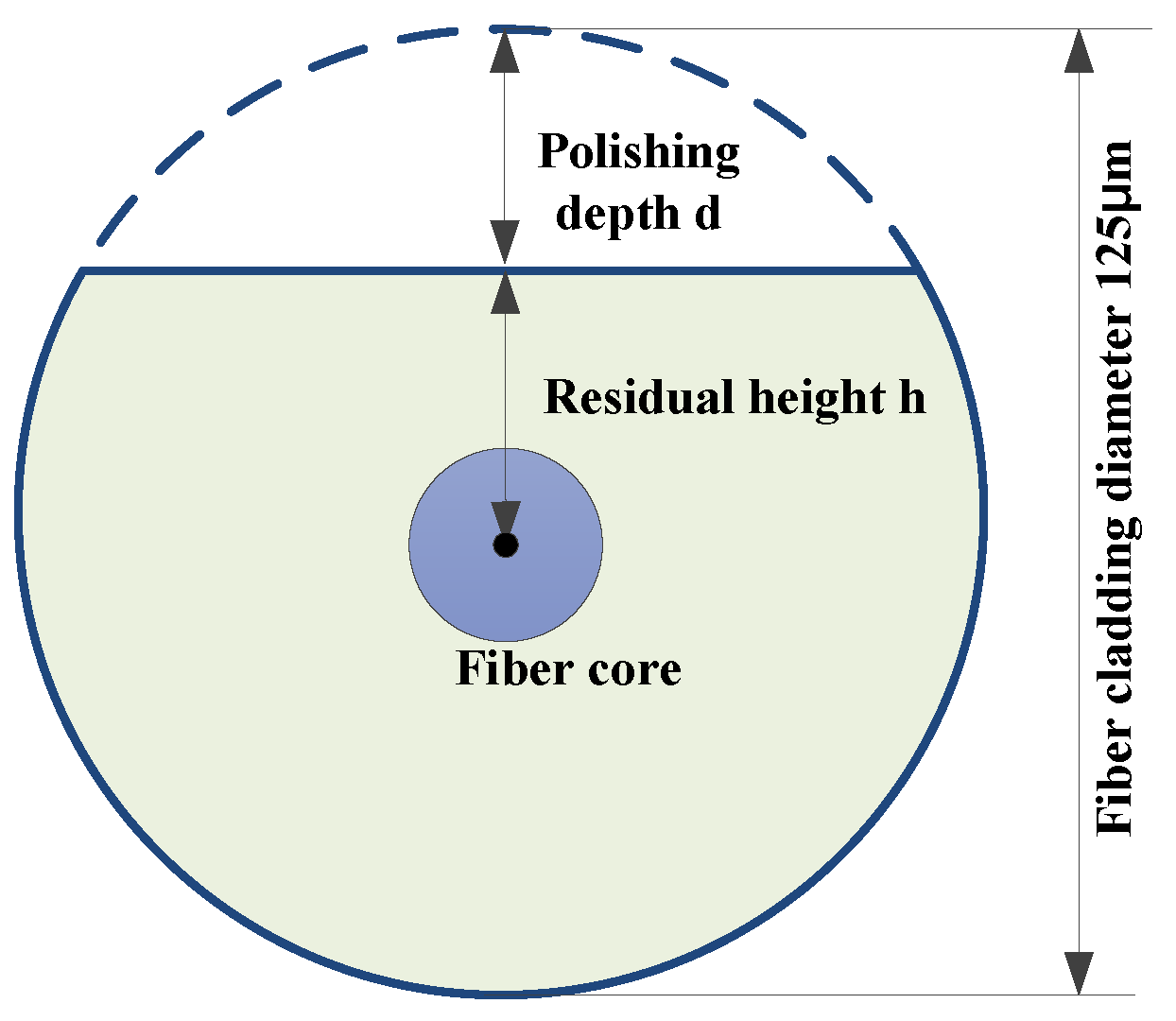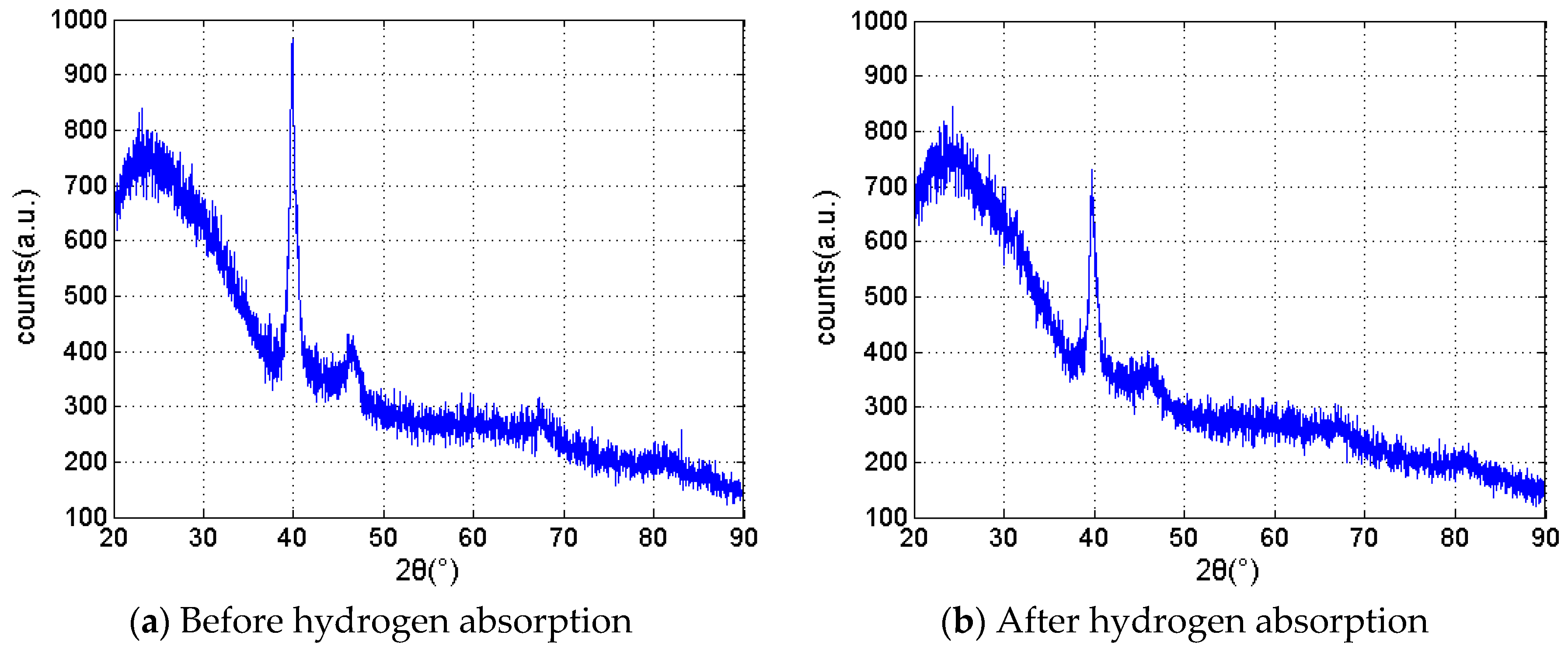Research on High Sensitive D-Shaped FBG Hydrogen Sensors in Power Transformer Oil
Abstract
:1. Introduction
2. Fabrication of D-Shaped FBG Sensors
2.1. Preparation of D-Shaped FBG
2.2. Magnetron Sputtering of Sensing Films
2.3. D-Shaped FBG Hydrogen Sensor
3. Experiment
3.1. Experimental Setup
3.2. Experimental Results
3.3. Membrane Analysis
4. Conclusions
Acknowledgments
Author Contributions
Conflicts of Interest
References
- Wang, K.; Tong, X.; Zhu, X. Transformer partial discharge monitoring based on optical fiber sensing. Photonic Sens. 2014, 4, 137–141. [Google Scholar] [CrossRef]
- Butler, M.A.; Sanchez, R.; Dulleck, G.R. Fiber Optic Hydrogen Sensor; Sandia National Laboratories: Livermore, CA, USA, 1996. [Google Scholar]
- Mak, T.; Westerwaal, R.J.; Slaman, M.; Schreuders, H.; van Vugt, A.W.; Victoria, M.; Boelsma, C.; Dam, B. Optical fiber sensor for the continuous monitoring of hydrogen in oil. Sens. Actuators B Chem. 2014, 190, 982–989. [Google Scholar] [CrossRef]
- Ma, G.M.; Li, C.R.; Mu, R.D.; Jiang, J.; Luo, Y.T. Fiber bragg grating sensor for hydrogen detection in power transformers. IEEE Trans. Dielectr. Electr. Insul. 2014, 21, 380–385. [Google Scholar] [CrossRef]
- Yang, M.H.; Dai, J.X.; Li, X.B.; Wang, J.J. Side-polished fiber Bragg grating refractive index sensor with TbFeCo magnetoptic thin film. J. Appl. Phys. 2010, 108, 033102. [Google Scholar] [CrossRef]
- Yan, H.T.; Liu, Q.; Ming, Y.; Lu, W.; Chen, Y.; Lu, Y.Q. Metallic Grating on a D-Shaped Fiber for Refractive Index Sensing. IEEE Photonics J. 2013, 5, 4800706. [Google Scholar] [CrossRef]
- Ma, G.M.; Mao, N.Q.; Li, Y.B.; Jiang, J.; Zhou, H.Y.; Li, C.R. The Reusable Load Cell with Protection Applied for Online Monitoring of Overhead Transmission Lines Based on Fiber Bragg Grating. Sensors 2016, 16, 922. [Google Scholar] [CrossRef] [PubMed]
- Jiang, J.; Ma, G.M.; Song, H.T.; Zhou, H.Y.; Li, C.R.; Luo, Y.R.; Wang, H.R. Note: Dissolved hydrogen detection in power transformer oil based on chemically etched fiber Bragg grating. Rev. Sci. Instrum. 2015, 86, 106103. [Google Scholar] [CrossRef] [PubMed]
- Ma, G.M.; Jiang, J.; Li, C.R.; Song, H.T.; Luo, Y.T.; Wang, H.B. Pd/Ag coated fiber Bragg grating sensor for hydrogen monitoring in power transformers. Rev. Sci. Instrum. 2015, 86, 045003. [Google Scholar] [CrossRef] [PubMed]
- Dai, J.; Yang, M.; Chen, Y.; Cao, K.; Liao, H.; Zhang, P. Side-polished fiber Bragg grating hydrogen sensor with WO 3-Pd composite film as sensing materials. Opt. Express 2011, 19, 6141–6148. [Google Scholar] [CrossRef] [PubMed]
- Dai, J.; Yang, M.; Yu, X.; Lu, H. Optical hydrogen sensor based on etched fiber Bragg grating sputtered with Pd/Ag composite film. Opt. Fiber Technol. 2013, 19, 26–30. [Google Scholar] [CrossRef]
- Miao, Y.P.; Bo, L. Refractive index sensor based on measuring the transmission power of tilted fiber Bragg grating. Opt. Fiber Technol. 2009, 15, 233–236. [Google Scholar] [CrossRef]
- Kinet, D.; Mégret, P.; Goossen, K.W.; Qiu, L.; Heider, D.; Caucheteur, C. Fiber Bragg grating sensors toward structural health monitoring in composite materials: Challenges and solutions. Sensors 2014, 14, 7394–7419. [Google Scholar] [CrossRef] [PubMed]
- Cai, Z.; Guo, T.; Liu, F.; Guan, B.O.; Peng, G.D.; Albert, J. Reflective refractometer based on strong optical coupling between a tilted fiber Bragg grating and a parallel D-shaped fiber. In Proceeding of the 24th International Conference on Optical Fibre Sensors, Curitiba, Brazil, 28 September 2015; pp. 96344I-1–96344I-4.
- Chryssis, A.N.; Lee, S.M.; Lee, S.B.; Saini, S.S.; Dagenais, M. High sensitivity evanescent field fiber Bragg grating sensor. IEEE Photonics Technol. Lett. 2005, 17, 1253–1255. [Google Scholar] [CrossRef]
- Bilro, L.; Alberto, N.J.; Sá, L.M.; de Lemos Pinto, J.; Nogueira, R. Analytical analysis of side-polished plastic optical fiber as curvature and refractive index sensor. J. Lightwave Technol. 2011, 29, 864–870. [Google Scholar] [CrossRef]
- Jang, H.S.; Park, K.N.; Kim, J.P.; Sim, S.J.; Kwon, O.J.; Han, Y.G.; Lee, K.S. Sensitive DNA biosensor based on a long-period grating formed on the side-polished fiber surface. Opt. Express 2009, 17, 3855–3860. [Google Scholar] [CrossRef] [PubMed]
- Lee, J.S.; Yoon, N.R.; Kang, B.H.; Lee, S.W.; Gopalan, S.A.; Jeong, H.M.; Kang, S.W. Response Characterization of a Fiber Optic Sensor Array with Dye-Coated Planar Waveguide for Detection of Volatile Organic Compounds. Sensors 2014, 14, 11659–11671. [Google Scholar]
- Iadicicco, A.; Cusano, A.; Cutolo, A.; Bernini, R.; Giordano, M. Thinned fiber Bragg gratings as high sensitivity refractive index sensor. IEEE Photonics Technol. Lett. 2001, 16, 1149–1151. [Google Scholar] [CrossRef]
- Yang, H.Z.; Ali, M.M.; Islam, M.R.; Lim, K.S.; Gunawardena, D.S.; Ahmad, H. Cladless few mode fiber grating sensor for simultaneous refractive index and temperature measurement. Sens. Actuators A: Phys. 2015, 228, 62–68. [Google Scholar] [CrossRef]









| DGA Value (μL/L) | Wavelength Shifts (pm) | Fitting Value (μL/L) | Error (μL/L) | Error Ratio |
|---|---|---|---|---|
| 0.0 | 0 | 7.2 | 7.2 | 0% |
| 115.6 | 58 | 99.6 | 16.0 | 8% |
| 217.4 | 112 | 205.5 | 11.9 | 2% |
| 296.9 | 161 | 301.6 | 4.7 | 1% |
| 408.6 | 245 | 466.3 | 57.7 | 12% |
| 502.4 | 279 | 533.0 | 30.6 | 5% |
| 719.7 | 350 | 672.2 | 47.5 | 6% |
© 2016 by the authors; licensee MDPI, Basel, Switzerland. This article is an open access article distributed under the terms and conditions of the Creative Commons Attribution (CC-BY) license (http://creativecommons.org/licenses/by/4.0/).
Share and Cite
Luo, Y.-T.; Wang, H.-B.; Ma, G.-M.; Song, H.-T.; Li, C.; Jiang, J. Research on High Sensitive D-Shaped FBG Hydrogen Sensors in Power Transformer Oil. Sensors 2016, 16, 1641. https://doi.org/10.3390/s16101641
Luo Y-T, Wang H-B, Ma G-M, Song H-T, Li C, Jiang J. Research on High Sensitive D-Shaped FBG Hydrogen Sensors in Power Transformer Oil. Sensors. 2016; 16(10):1641. https://doi.org/10.3390/s16101641
Chicago/Turabian StyleLuo, Ying-Ting, Hong-Bin Wang, Guo-Ming Ma, Hong-Tu Song, Chengrong Li, and Jun Jiang. 2016. "Research on High Sensitive D-Shaped FBG Hydrogen Sensors in Power Transformer Oil" Sensors 16, no. 10: 1641. https://doi.org/10.3390/s16101641





